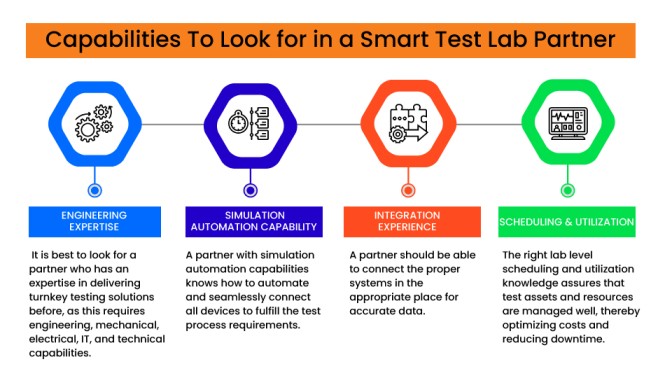Test facility managers are inundated with demands to optimize test labs to drive greater accuracy, maximize productivity, and improve costs. As manufacturing enters the age of extreme automation and Industry 4.0, the range of development and testing tasks increases in number.
Product development and products themselves become complex, demanding more accurate and precise test results than ever before. Smart test beds have now emerged as the essential imperatives that drive product development by adding velocity and accuracy to the testing process and generating accurate test results in shorter time frames.
This demand has led to the rise of smart test beds over traditional testing. However, when setting up the smart test lab, selecting the right smart test lab partner can be a differentiator between success and frustration.
This begs the question – who is the right partner? Let’s break it down.

Engineering Expertise
When evaluating testing partners for setting up a smart test lab, it is imperative to look for someone with the right engineering expertise. Looking at a partner with expertise in engineering turnkey testing solutions is a good starting point.
This is important as it ensures that the partner can provide a clear and ideal testing solution and ensure that all the testing considerations are fulfilled with ease.
If we look at EV testing, for example, the testing partner:
- Must know how to create a smart test bed and what equipment to use.
- Must assess the infrastructure needed to validate the performance of entire engines or the sub-components of engines for R&D or certification tasks.
The ability to simulate the real load conditions on different UUTs and build a truly integrated and connected environment that provides accurate test results become crucial for EV testing.
Along those lines, an expert partner will help identify the right test systems and objects and bring awareness to global standards. Having the right partner eases off the load while ensuring all the essential parts are addressed and catered to.
It is best to look at a partner with experience in delivering turnkey testing solutions as this needs engineering, mechanical, electrical, and technical capabilities. A partner with the right skill sets ensures that the facility is designed as desired and delivers the expected output.
Simulation Automation Capability
Testing has to be optimized to meet today’s dynamic needs. With customer preferences and market trends driving product evolution, developing the capacity to test fast, test often, test comprehensively, and test confidently emerge as the new goals.
Traditionally, testing has fixed sequences that lead to the data. However, with the digital transformation of the manufacturing unit, automation systems in place have to become more intelligent and performance-driven.
A partner with simulation automation capabilities knows how to automate and seamlessly connect all devices to fulfill the test process requirements. They also ensure clean integration of automation systems with the hardware and allow organizations to bring in data from test cases in the real world and simulate it successfully in a lab.
Simulation automation capabilities become enablers of testing velocity and increase testing confidence. Looking at the simulation automation capabilities, the experience of setting up these systems, and the capacity to build a comprehensive, controlled test environment with login authentication are things to evaluate.
Integration Experience
A smart test bed has many components, each of which needs to be completely and seamlessly interconnected for great test results. A test lab, for example, will have test beds and test equipment. They will then need automation systems to automate manual processes. There is a simulation system that needs to be added to the mix for simulation automation.
The test equipment needs exact calibration along with the right sanity checks to ensure accurate test results and that the test bed can start without any (or low) human intervention.
The partner should know how and where to put sensors and connect them to the right systems for accurate data. They should be able to add the simulation components in the right places and connect them with the right systems.
Along with this, they also need to connect multiple test beds in use and join them to the second-level hosts to capably create a central repository for all test sequences.
Lab Level Scheduling and Utilization
Integrating the test system as one allows organizations to run standardized tests with greater ease and confidence. It also enhances an organization’s ability to drive optimized utilization of the smart lab with lab-level scheduling and utilization.
The smart lab partner has to know how to enable the digital transformation of the testing process. Along with driving interconnectedness, they should also capably facilitate better asset and resource utilization.
The right lab level scheduling and utilization knowledge assure that test assets and resources are managed well, thereby optimizing costs and reducing downtime. Along those lines, the right partners ensure that the lab level scheduling is enhanced and the test facility is neither overused nor underused.
They help plan and implement the right maintenance schedules and ensure minimal downtime using predictive and preventive maintenance.
Summing Up
The right partnership helps organizations save costs and eliminate expensive mistakes that can stem from incorrect test data because of less-than-optimal integrations and connections.
Experienced partners ensure that they get the test ‘first time right.’ This profoundly influences profitability by eliminating the time, energy, and resources spent repeatedly testing the same object.
As such, they help discover the best combinations and calibrations and connect the hardware and software elements to drive testing accuracy and velocity. They also provide creative solutions to utilize existing assets and identify the means and processes to make these smarter and future-ready.



